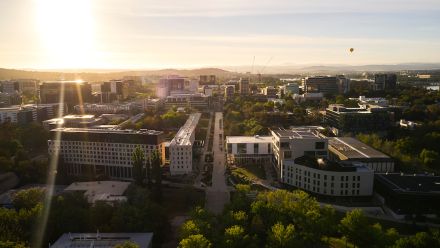Australia’s environment rebounds after record heat and fire
The number of days exceeding 35 degrees Celsius was the lowest since 2011, so it was generally less hot last year.
Lower temperatures and good rainfall, in part due to La Niña, have helped Australia's environment strongly recover following record hot temperatures, drought and a catastrophic bushfire season two years ago, according to the 2021 Australia's Environment Report.
The annual report is prepared by researchers from The Australian National University (ANU) with support from the Terrestrial Ecosystem Research Network (TERN).
The researchers analyse vast amounts of satellite and field measurements and convert that data into an overall environmental condition score.
The latest report also warns Australia's biodiversity has suffered.
In 2021, Australia's environment scored a 6.9 out of 10, more than double the score in 2020 when the country's environment was given a three out of 10 following the Black Summer bushfires of 2019 and 2020.
Conditions improved for all states and territories in 2021, but the largest improvements occurred in Western Australia and Tasmania.
"Above average rainfall and lower temperatures not seen for eight years have contributed to a strong further recovery of Australia's environment in 2021," lead author Professor Albert van Dijk said.
"We've seen strong signs of recovery in all states and territories thanks to low fire activity, eased drought conditions and good rainfall which replenished parched soils, improved vegetation and led to better growing conditions.
"The extraordinary rainfall in recent weeks in parts of New South Wales and Queensland added water to catchments, rivers and dams that had already replenished in 2021.
"That contributed to the dramatic floods we have seen."
Although ecosystems showed strong signs of recovery, Australian biodiversity continued to suffer in 2021.
Twelve Australian species were declared extinct in 2021 and 34 more were added to the Threatened Species List, according to the latest government data.
"The two most recent extinctions were a little bat and a skink last seen on Christmas Island in 2009 and 2010," PhD scholar Shoshana Rapley, from the ANU Fenner School for Environment and Society, said.
"There was supposed to be a plan to protect those species.
"It is a wake-up call that threatened species conservation needs to be taken more seriously, otherwise we risk further losses of our rich and unique biodiversity and the essential services they provide.
"On the other hand, 16 new species were discovered in 2021, including spiders, frogs, an octopus and others.
"Of course, we had those species all along without realising it, so that doesn't mean biodiversity is improving."
According to the report, Australia's carbon emissions decreased by almost two per cent, although this is primarily due to the COVID-19 pandemic.
"Australia contributed 1.4 per cent to global emissions in 2021, compared to 1.5 per cent in 2020. However, per-capita emissions remain among the highest globally due to high individual energy use, the continued use of polluting coal, and large non-carbon dioxide emissions," Professor van Dijk said.
The report also found 2021 was the sixth warmest year on record.
"Record warm July temperatures were measured in some areas in inland Australia, but otherwise not many records were broken and that's good to see for a change," Professor van Dijk said.
"The number of days exceeding 35 degrees Celsius was the lowest since 2011, so it was generally less hot last year."
According to Professor van Dijk, the continued impact of climate change on heatwaves, drought and bushfires will continue to degrade our environment and ecosystems for decades to come.
He says a global response similar to the one taken to combat the COVID-19 pandemic and Russia's invasion of Ukraine will be needed to prevent our environmental crisis from worsening.
"Decisive action to actively reduce global carbon emissions and improve ecosystem management can avoid these impacts from becoming worse than they have to be," he said.
"Both are entirely within our reach, but only if the necessary action is taken."
The 2021 Australia's Environment Report, which gives each state and territory an environmental condition score, is available here. Scores are also available for local government areas, catchments and electorates.


